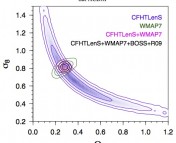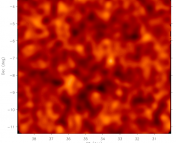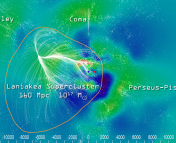- Title: Testing cosmic geometry without dynamic distortions using voids
- Authors: N. Hamaus, P. M. Sutter, G. Lavaux, B. Wandelt
- First author’s institution: Sorbonne Universites, Institut d’Astrophysique de Paris & CNRS, Paris, France.
- Status: prepared for submission to JCAP.
The distribution of matter in the Universe has much to say about its constituents and evolution. The authors of this paper challenge our view of the large-scale structure of the Universe by studying the counterpart of the distribution of matter – the distribution of cosmic voids.
The matter and energy content of the Universe, and its evolution, are encoded in the spatial distribution of galaxies. Primordial fluctuations in the gas that made up the Universe 380,000 years after the Big Bang collapsed by gravity to form the first stars and galaxies. Galaxies clustered, forming a network of walls, filaments, clusters and voids, that we know as the large-scale structure. This clustering is usually measured through the correlation function of galaxies, which gives the excess number of galaxy pairs as a function of separation, relative to the expected number if galaxies where distributed at random. Alternatively, one can think of the correlation function as giving a characteristic scale for the separation of galaxies.
In 1979, Alcock and Paczynski devised a test that would give information on the properties of the Universe. They proposed that any spherically symmetric structure in space should have the same dimension on the plane of the sky and along the line of sight. This applies in particular to the characteristic separation of galaxies. This scale should be the same if measured from the angular separation of galaxies in the sky, or from their separation along the line of sight (or redshift). This test is useful for constraining the expansion history of the Universe and the nature of the mysterious dark energy. One drawback of the Alcock and Paczynski test is the fact that galaxies are not at rest. The measurement of their position along the line of sight is actually subject to distortion due to the component of their velocity in that direction. The novelty of this paper is the idea that there is a characteristic scale of separation between cosmic voids to which the Alcock-Paczynski test can be applied and that is not subject to the velocity uncertainty.

Figure 1. The correlation function of galaxies (left), voids and galaxies (middle) and between voids (right) from numerical simulations of the Universe. The x-axis is the separation on the plane of the sky and the y-axis gives the separation along the line of sight. The correlation between voids shows more symmetry between the two directions because voids are not affected by velocity distortions. Adapted from Figure 1 of Hamaus et al.
The authors use simulations of the Universe to demonstrate this in Figure 1, where they compare the correlation function of galaxies, the cross-correlation of voids and galaxies, and the correlation between voids. The correlation function is shown color-coded and contoured as a function of separation on the sky (x-axis) and along the line of sight (y-axis). The contours look more symmetrical for the correlation between voids (right panel), while the correlation between galaxies or between galaxies and voids are subject to distortions due to the velocities of galaxies. On large scales, galaxies tend to fall towards overdensities, squashing the correlation function along the line of sight. On small scales, the velocities become much larger and harder to predict, smearing the correlation (although this effect is harder to see in Figure 1 because of its resolution).
The authors study the sensitivity of the ellipticity of the contours shown in Figure 1 to changing the properties of the Universe. They find that void correlations can provide a cleaner result for the Alcock and Paczynski test at redshift of ~1 and only if compared to the distribution of galaxies on large scales. At lower redshifts and on smaller scales, galaxies continue to provide better constraints on the expansion history of the Universe. A combination of both methods should be explored. With the advent of deeper and larger galaxy redshift surveys in the upcoming decade (such as Euclid and WFIRST), voids might claim a role in precision cosmology.




